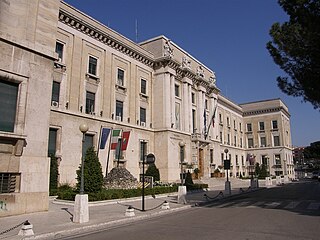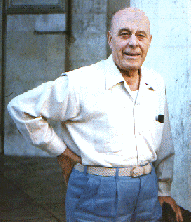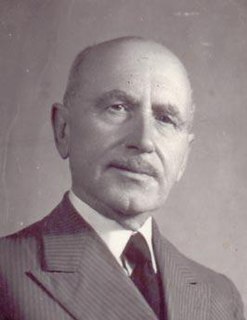
Giuseppe Misticoni (1907 - 1998) was an Italian painter and sculptor, active in the Abruzzo.

Giuseppe Misticoni (1907 - 1998) was an Italian painter and sculptor, active in the Abruzzo.
Giuseppe Misticoni was born in Spoltore, to a family originally from Morro d’Oro, near Teramo. Giuseppe was initially mentored by the local painter Italo De Sanctis, and from there moved to study at the Liceo Artistico and then at the Accademia di Belle Arti di Roma.
During the war, he was sent to the Albanian front in 1940. He was made prisoner of the Greeks, but escaped and made his way back to the partisan resistance, only to return to Italy in 1946. [1]
He moved back to Pescara, where in 1947 he founded the Liceo Artistico, which he directed for 30 years, and which still bears his name. Among his pupils and colleagues at the Liceo were his long-time friend, Giuseppe Di Prinzio; Nicola Febo; Elio Di Blasio; Franco Summa; Giovanni Melarangelo; Arduino Napoleone; Enio D’Incecco; and Giovanni Pittoni.
In the 1950s, Misticoni produced abstract works. He continued to exhibit at the Biennale di Venezia and the Quadriennale di Rome. His works are displayed in the Museo Costantino Barbella of Chieti, la Galleria d’Arte Moderna of Lucca, the Pinacoteca of L’Aquila, and other public and private galleries. [2]

The province of Pescara is a province in the Abruzzo region of Italy. Its provincial capital is the city Pescara, which has a population of 119,483 inhabitants. As of 2017, it has a total population of 319,936 inhabitants over an area of 1,230.33 square kilometres (475.03 sq mi). The provincial president is Antonio Zaffiri and the province contains 46 comuni.

Benedetto Luti was an Italian painter.

Giovanni Andrea Ansaldo was an Italian painter active mainly in Genoa.
Giuseppe Natali (1652–1722) was an Italian painter of the Baroque period, active mainly in Cremona and Lombardy.
Sebastiano Guala was an Italian church architect active between 1640 and 1680 in the area of Casale Monferrato, then capital of the Gonzaga-ruled state of Montferrat. He was born into a prominent family of Frassinello Monferrato and became a canon of the Collegiata di Santa Maria di Piazza in Casale. It has been thought probable that he belonged to the same family as the Casalese painter Pier Francesco Guala (1698–1757).
Giuseppe Tontodonati was an Italian poet.

Andrea Maffei was an Italian poet, translator and librettist. He was born in Molina di Ledro, Trentino. A follower of Vincenzo Monti, he formed part of the 19th-century Italian classicist literary culture. Gaining laurea in jurisprudence, he moved for some years to Verona, then to Venice and finally to Milan, where in 1831 he married contessa Clara Spinelli. They separated by mutual consent on 15 June 1846.

Ulisse Cambi was an Italian sculptor active in Tuscany during the 19th century.

Armando Spadini was an Italian painter and one of the representatives of the so-called Scuola Romana.
Giovanni Di Giorgio was an Italian painter, mainly of genre subjects in oil and acquaforte. After studying at the Liceo artistico, he enrolled at the Institute of Fine Arts of Naples, under Pietro Barillà, Alberto Chiancone, and Eugenio Viti. Di Giorgio had won various awards for fresco and oil painting. He obtained a subsidy in 1939 to travel to Monza and study under Pio Semeghini and Raffaele De Grada. In 1937, he had exhibited a number of xerographs at the Circolo artistico Italo-Romano. Returning to Aversa in 1942, he taught design at the local School, and after 1970, was director of the Liceo Artistico Statale. Among his works are Dolenti note and Idillio campestre. He also illustrated books.
Angelo Frattini was an Italian sculptor from Varese. He studied at Brera Academy and his first contacts with sculptural art were influenced by Scapigliatura's teachings. He also exhibited his works in New York City and Washington DC, where he was received by president Lyndon Johnson. Angelo Frattini died in Varese on September 2, 1975. In 1978 the artistic lyceum of his hometown was named after him.
Andrea de Litio was an Italian painter.

Giuseppe Renda, called "l'Aroddu", was an Italian painter.

Domenico Cantatore was an Italian painter, mosaic artist and illustrator. His style, somewhat naive, is influenced by Cezanne, Matisse, and the Expressionists. His main focus was portraiture and the exploration of historical themes, in particular the figure of the reclining odalisques.
Italo De Sanctis (1881–1943) was an Italian painter, known for his portraits.
Tommaso Cascella senior (1890–1968) was an Italian painter, known for brightly colored landscapes.

Raffaello Celommi was an Italian genre and seascape painter.
Emilio Notte was an Italian painter, active in a Futurist style.

The Liceo ginnasio Emanuele Duni is an Italian high school located in Matera, in the region of Basilicata in Southern Italy. It is named after Italian philosopher Emanuele Duni, professor of canon and civil law at the University of Rome. It is best known for having been the school where the Italian poet Giovanni Pascoli worked as a teacher in the two-year period 1882–1884.

The Basilio Cascella Civic Museum is an Italian pinacotheca based in Pescara in the Porta Nuova district. The museum is located in the former lithographic establishment established at the end of the nineteenth century by the painter Basilio Cascella. The building, for half a century the center of artistic production and meeting place for intellectuals such as Gabriele D'Annunzio, Luigi Pirandello, and Giovanni Pascoli, was donated to the Comune of Pescara in 1966 by the heirs of Cascella.